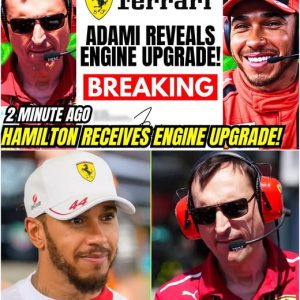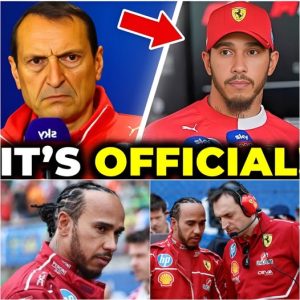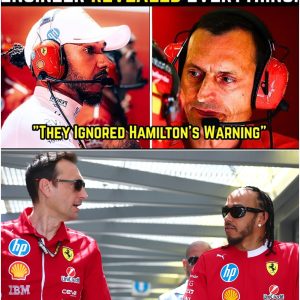Ferrari, the most legendary name in Formula 1, has always been more than a racing team. It is a cultural institution, a national symbol, and the embodiment of passion on four wheels. The Prancing Horse has tasted glory and endured droughts, but through it all, Ferrari has remained synonymous with racing tradition.
In 2025, however, that tradition is being tested like never before. The arrival of seven-time world champion Lewis Hamilton was meant to spark a new golden era for the Scuderia. Instead, it has exposed deep cracks within the team’s foundations.
The Hungarian Grand Prix provided the latest—and perhaps most shocking—glimpse into Ferrari’s internal storm. A brief, emotional team radio message from Hamilton has ignited a firestorm of speculation about the driver’s relationship with his engineer, Ricardo Adami, and the broader struggle for control inside Maranello.
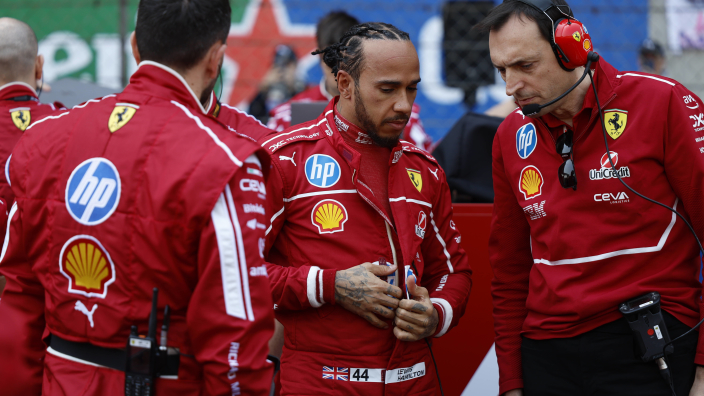
The Two Words That Shook Ferrari
The drama unfolded at the Hungaroring, where Hamilton, frustrated by the handling of his Ferrari, uttered just two words over the radio: “I’m useless.”
To the casual fan, it sounded like the fading cry of a once-dominant champion. But for those who know Hamilton, the words carried far more weight. This was not surrender—it was a signal of war.
Ricardo Adami, Hamilton’s experienced race engineer, responded with his usual calm. Yet within that reply came a brief pause, a hesitation that spoke louder than any instruction. In Formula 1, silence can be deafening. It hinted at internal conflict, political pressure, and perhaps even doubt over whether Hamilton’s voice truly carries weight within Ferrari.
Hamilton vs. Ferrari Tradition
Hamilton’s arrival at Maranello was always going to be disruptive. The Briton is no ordinary driver—he is outspoken, analytical, and relentless in his pursuit of perfection. His approach often involves questioning decisions, pushing boundaries, and demanding that every detail be optimized around his style.
This, however, runs counter to Ferrari’s traditional culture. For decades, the team has prided itself on caution, stability, and loyalty to its long-term philosophy.
At the heart of that philosophy is Charles Leclerc. The Monegasque has become Ferrari’s “prince”—a loyal, consistent performer whose smooth driving style and alignment with Ferrari’s methods make him the perfect face of tradition.
Thus, the team finds itself torn between two visions:
Hamilton’s adaptive, aggressive, risk-taking philosophy, which seeks radical change.
Leclerc’s stable, precise, and tradition-aligned style, which favors steady evolution.
This clash is not simply about car setups or strategy. It is about Ferrari’s very identity.

The Setup Rebellion in Hungary
The tension in Hungary began long before the race. Throughout practice, Hamilton complained about the car’s instability at the rear and inconsistent throttle response. He pushed hard for significant suspension changes, believing them essential to unlock race-winning pace.
Yet, in a dramatic twist, Ferrari’s strategy desk rejected Hamilton’s request just hours before the start. Instead, the car was adjusted in line with the team’s broader optimization plan—changes that leaned toward Leclerc’s style and Ferrari’s developmental philosophy.
For Hamilton, this was not merely a technical disagreement. It was a message: Ferrari’s hierarchy still held the power, and he was expected to adapt rather than dictate. To him, it felt as if he had been deliberately sent into battle with a compromised machine, reduced to a pawn in Ferrari’s long-term experiment.
When Hamilton spat out “I’m useless” at 300 km/h, it was not just an outburst of frustration. It was an indictment of Ferrari’s decision-making process and his growing sense of marginalization.
The Fragile Bridge of Trust
In Formula 1, the relationship between driver and race engineer is sacred. The engineer is not just a messenger of data but the driver’s lifeline—a strategist, psychologist, and confidant who must earn unwavering trust.
Adami now finds himself in the most delicate position of his career. His role is no longer limited to translating telemetry into instructions. Every word he utters is weighed against the competing interests of Hamilton, Leclerc, and Ferrari’s upper management.
That split-second pause in Hungary symbolized the cracks forming in that bridge of trust. And when that bond weakens, the consequences can ripple through the entire team. In a sport defined by milliseconds, a breakdown in communication can be the difference between victory and defeat.
Hamilton’s Counterattack
After Hungary, Hamilton shifted gears—figuratively, if not literally. Gone were the raw, emotional radio outbursts. In their place came a cooler, more methodical Hamilton.
He doubled down in the simulator, insisting on testing his preferred setups until data validated his instincts. He arrived at technical meetings with detailed notes, turning every complaint into documented evidence of his contribution. Gradually, Adami began backing Hamilton more strongly in discussions, a subtle but significant shift that hinted at a growing alliance.
Within Ferrari’s corridors, this sparked debate. Some saw it as a natural evolution of trust between driver and engineer. Others whispered that it was the beginning of a silent rebellion, one that could tilt Ferrari’s development path away from Leclerc’s style.
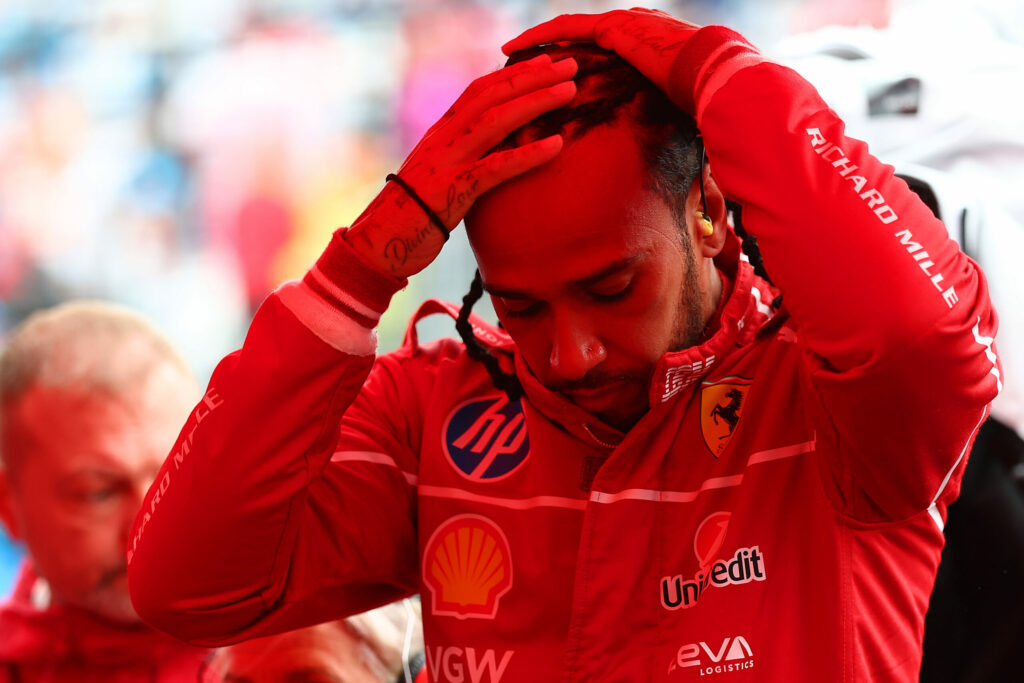
Leclerc vs. Hamilton: The Battle of Philosophies
The contrast between the two Ferrari stars could not be clearer.
Hamilton thrives on extremes. He embraces risky experiments, searches for unconventional solutions, and believes that bold innovation is the only path to beating Red Bull.
Leclerc excels in stability. His precise, measured approach aligns with Ferrari’s conservative DNA, ensuring consistency even if it means sacrificing peaks of performance.
The choice Ferrari faces is monumental: build a car around Hamilton’s unpredictability, or double down on the reliable platform that suits Leclerc.
This is no longer just a technical debate. It is a question of Ferrari’s soul.
All Roads Lead to Monza
The internal storm now heads toward Ferrari’s home race at Monza—the Temple of Speed.
For Ferrari, Monza is sacred ground. The grandstands will be a sea of red, filled with tifosi whose emotions can sway from ecstasy to despair in the blink of an eye. Every pit stop, every strategy call, and every radio message will be dissected not just by analysts but by millions of passionate fans.
If Ferrari leans toward Hamilton’s strategy at Monza, it would be a bold statement: that the Scuderia is ready to break from tradition and place its future in the hands of a seven-time champion determined to reshape the team.
If Leclerc is favored, it would reaffirm Ferrari’s loyalty to its homegrown star, signaling that the team values consistency and tradition over Hamilton’s disruptive influence.
Either choice will define Ferrari’s trajectory—not only for this season but for years to come.
Ferrari’s Identity Crisis
The saga of Hungary and the build-up to Monza reveal more than just a driver-team dispute. They expose Ferrari’s existential struggle.
Is Ferrari destined to remain bound by its history, cautious in its choices, and loyal to tradition? Or can it evolve into a modern, flexible powerhouse capable of embracing radical change?
Hamilton’s mission is clear: to drag Ferrari into a new era, even if it means clashing with decades of culture. For Leclerc, the aim is equally vital: to preserve Ferrari’s essence while delivering the consistency fans crave.
The outcome of this internal war will decide whether Ferrari remains trapped in the shadow of its past or dares to embrace a bolder, riskier future.
Conclusion: The Road Ahead
The words “I’m useless” were more than an emotional outburst. They were a spark, illuminating the tension between Ferrari’s past and its potential future.
As Formula 1 barrels toward Monza, Ferrari finds itself at a crossroads. With Hamilton and Leclerc embodying two opposing philosophies, the team must choose its identity.
Whatever decision is made—whether to empower Hamilton’s revolution or preserve Leclerc’s tradition—the consequences will echo far beyond a single race weekend. They will shape Ferrari’s destiny in Formula 1’s modern era.
For now, the tifosi wait, hearts pounding, to see whether the Prancing Horse can unite under pressure or fracture beneath the weight of its own history.
